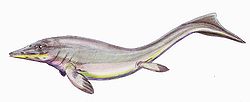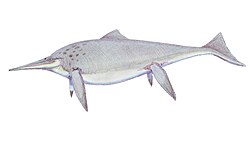| Caypullisaurus | |
|---|---|
 | |
| Dakosaurus (right) pursuing a Caypullisaurus (left) | |
| Scientific classification | |
| Kingdom: | Animalia |
| Phylum: | Chordata |
| Class: | Reptilia |
| Order: | † Ichthyosauria |
| Family: | † Ophthalmosauridae |
| Subfamily: | † Platypterygiinae |
| Genus: | † Caypullisaurus Fernández, 1997 |
| Species: | †C. bonapartei |
| Binomial name | |
| †Caypullisaurus bonapartei Fernández, 1997 | |
Caypullisaurus is an extinct genus of platypterygiine ophthalmosaurid ichthyosaur from the Late Jurassic to the Early Cretaceous (Tithonian and Berriasian stages) of Argentina. Its holotype was collected from the Vaca Muerta Formation of Cerro Lotena, Neuquen, dating to the early Tithonian stage of the Late Jurassic, about 150 million years ago. Caypullisaurus was first named by Marta Fernández in 1997 and the type species is Caypullisaurus bonapartei. It was a large ichthyosaur, measuring about 7 m (23 ft) long. [1] [2] The forelimbs of Caypullisaurus contained 10 digits each. [3]







